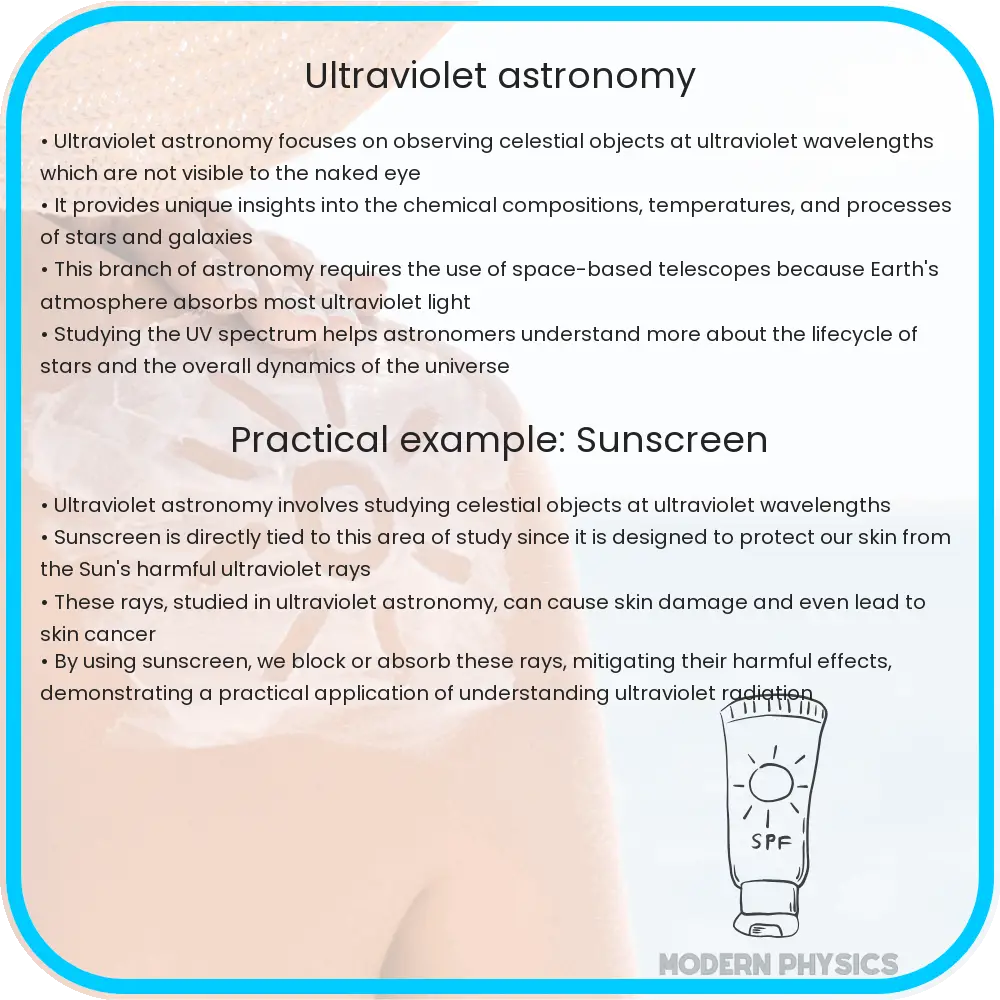Explore the intriguing world of Ultraviolet Astronomy, covering key discoveries, techniques, equipment, and the future prospects shaping our understanding of the cosmos.

Introduction to Ultraviolet Astronomy
Ultraviolet (UV) astronomy is a dynamic field that explores the universe through ultraviolet wavelengths, lying between visible light and X-rays in the electromagnetic spectrum. This branch of astronomy is pivotal for understanding the life cycle of stars, the composition of galaxies, and the intricacies of the interstellar medium. UV observations can reveal properties of celestial objects that remain invisible in other wavelengths, providing unique insights into cosmic phenomena.
Key Discoveries in Ultraviolet Astronomy
One of the hallmark discoveries of UV astronomy includes the identification of hot, young stars that emit predominantly in the ultraviolet range. These findings have significantly contributed to our understanding of star formation and evolution. Additionally, UV observations have played a crucial role in studying the large-scale structure of the universe, revealing the presence of the cosmic web – a vast network of intergalactic gas and dark matter.
Another significant area of discovery is the chemical composition of stars and galaxies. Through UV spectroscopy, astronomers can identify the presence of various elements and compounds, such as hydrogen (H2), helium (He), and carbon dioxide (CO2), enabling detailed studies of celestial chemistry and dynamics.
Techniques and Equipment in UV Astronomy
UV astronomy requires specialized techniques and equipment, as Earth’s atmosphere absorbs the majority of UV radiation. Consequently, most UV observations are conducted using space-based telescopes. Notable examples include the Hubble Space Telescope (HST) with its Ultraviolet Imaging Spectrograph, and the Galaxy Evolution Explorer (GALEX), which has contributed immensely to our understanding of galaxy evolution.
Techniques such as UV spectroscopy allow astronomers to dissect the light from celestial objects, revealing information about their temperature, composition, and movement. Imaging and photometry in the UV band also provide insights into the structure and dynamics of astronomical objects, from the small scale of asteroids to the vastness of entire galaxies.
Advancements and Challenges in Ultraviolet Astronomy
Recent advancements in UV astronomy have been driven by technological innovations, particularly in UV detectors and telescope design. Enhanced sensitivity and resolution have allowed astronomers to probe deeper into the universe and observe fainter objects. Additionally, the development of UV-optimized space telescopes has expanded our ability to conduct detailed surveys of the sky in ultraviolet light.
However, UV astronomy faces several challenges. The need for space-based observations significantly increases the cost and complexity of missions. Furthermore, UV detectors require stringent calibration due to their sensitivity to different types of radiation. The field also contends with the issue of data interpretation, as UV radiation is often influenced by various astrophysical processes, making it challenging to disentangle the different contributing factors.
Future Prospects in Ultraviolet Astronomy
The future of UV astronomy holds promising prospects with upcoming missions and technological advancements. New telescopes, such as the James Webb Space Telescope, are expected to further extend our UV observation capabilities. Additionally, international collaborations are paving the way for more sophisticated and capable UV observatories. These developments are anticipated to unravel more mysteries of the cosmos, from the detailed mechanisms of star formation to the behaviors of active galactic nuclei.
Furthermore, advancements in computational techniques, such as machine learning and data analytics, are expected to enhance the processing and interpretation of UV data. This will enable more accurate modeling of celestial phenomena and a deeper understanding of the complex processes at work in the universe.
Conclusion
Ultraviolet astronomy stands as a cornerstone in our quest to comprehend the vast universe. Through the lenses of specialized telescopes and innovative techniques, astronomers have uncovered phenomena that reshape our understanding of cosmic evolution and dynamics. Despite its challenges, the field continues to evolve, driven by technological advancements and a relentless pursuit of knowledge. As we stand on the brink of new discoveries, ultraviolet astronomy promises to continue illuminating the mysteries of the cosmos, offering insights into the uncharted territories of the ultraviolet universe.
